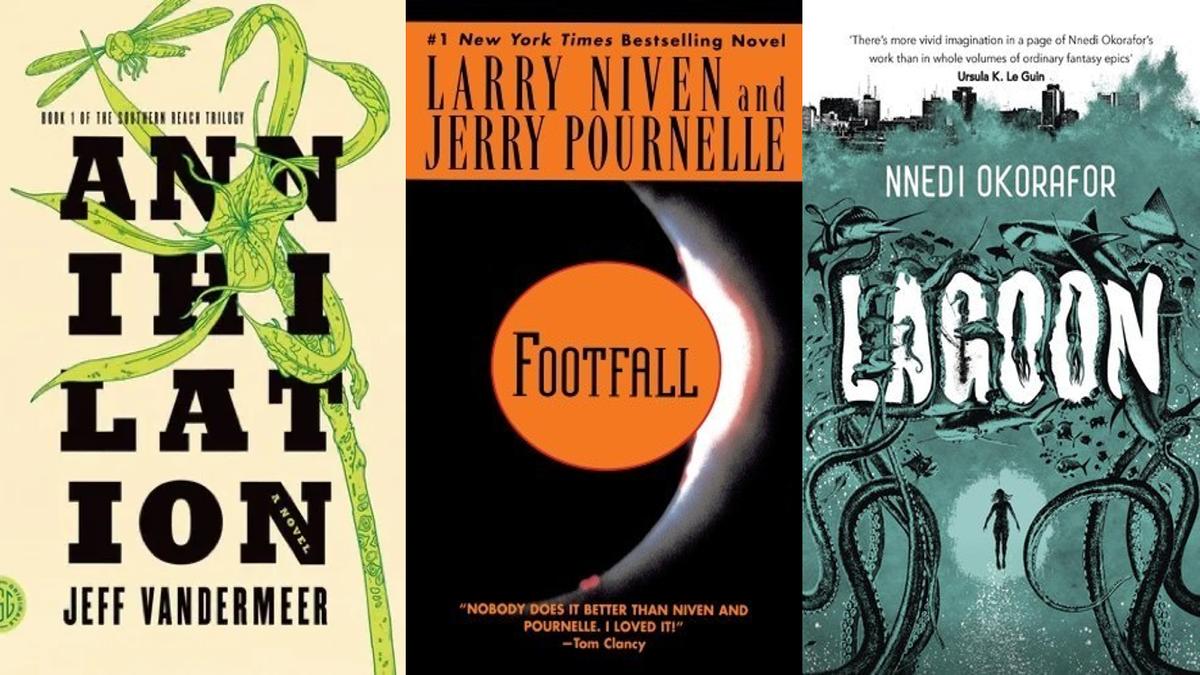
For centuries, humans have looked up at the stars wondering if there are creatures “like us” out there. Science fiction authors have offered cautionary advice: “careful what you wish for.” What if extraterrestrials are a little too like us? I.e. homicidal resource guzzling maniacs with an innate drive to expand and control? If aliens are indeed enlightened, they’re probably smart enough to leave murder-primates like us alone. If they’re not, then human civilization might soon get a taste of its own killer medicine. Here are the 10 best sci-fi books about alien invasions, written so wishful thinkers like you can start preparing for interstellar combat instead.
The Three Body Problem

A modern sci-fi war epic, Cixin Liu’s The Three Body Problem is one of the most celebrated alien invasion books of the modern era. Book one of the Remembrance of Earth’s Past trilogy, Liu’s novel takes its title from a problem that has plagued physicists for centuries. When three or more celestial bodies are in orbit around each other, their movements are nearly impossible to predict. When you’re an alien species living on a planet that orbits three suns, solving the three body problem isn’t just a theoretical conundrum – it’s the key to your survival. The solution? Abandon your planet and look for a more hospitable place. That blue one a few lightyears away looks pretty nice – if you were to get rid of the organisms already living on it. Trouble is, those inconvenient organisms are us, and we now alien invasion on its hands! Hard problems call for hard solutions, and this hard sci-fi novel packs a hard hitting punch.
War of The Worlds

The original alien invasion novel, H.G. Wells’ War of The Worlds remains a horrifying genre stalwart to this day. Originally published in the late 19th century, this novel inspired a mass panic after a radio adaptation was mistaken for a real broadcast. In the mid-1980’s, the Reagan years interrupted by the arrival of Martian invaders, who are attempting to conquer the Earth using walking death machines. The Red Planet’s terrifying tripods are equipped with heat rays that are capable of vaporizing people on contact – which the Martians utilize. A lot. A deeply unsettling novel, War of The Worlds imagines humanity pitted against a creature even more sociopathic than ourselves – and far more technologically advanced. I don’t know about you, but I wouldn’t wanna be us in that situation.
The Seep

Chana Porter’s The Seep features an alien invasion that’s over as quickly as it began. After the Earth is visited by a Lovecraftian super-intelligence calling itself “The Seep,” the kindly cosmic horror offers to rid humanity of all suffering. Free from war and want, humanity now has the time to pursue its wildest dreams using Seep-based technology. For Trina Goldberg-Oneka’s wife Deeba, that “wildest dream” is reliving life as a blissfully unaware infant. After Deeba ditches her wife to take the form of a bouncing baby, Trina is left devastated. Fueled by heartbreak and alcohol, Trina resolves herself to free the world from The Seep’s influence – one person at a time. At its core, this novel is a deconstruction of the false promise of utopia. There can always be trouble in paradise, as Trina so tragically learns.
Childhood’s End

Another “benevolent invasion” story, Arthur C. Clarke’s Childhood’s End is the chronicle of humanity’s visit from The Overlords – a hyper-advanced group of beings more peaceful than their tyrannical name implies. After establishing contact with humanity, the promise to rid us of war, disease, and hunger – by ridding us of art and culture in the process. As the novel progresses, humanity and its hybrid descendants realize that the Overlord’s promise of paradise comes in exchange for our souls. In ridding us of everything that makes us, well, us, they’re attempting to ascend humanity to a heightened state of hive mind consciousness. I’d rather keep my love of Baldur’s Gate 3 and Poptarts than have interconnectivity with a universal superconsciousness, thank you very much. The humans of this novel may have wanted the same, but once they let the Overlords in, it was already too late .
Footfall
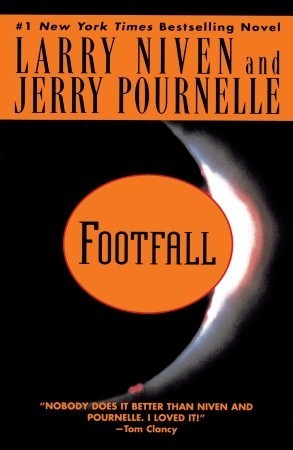
Footfall by Larry Niven and Jerry Pournelle is the story of humanity’s troubled encounter with the Fithp, an alien species that look like baby elephants with multiple trunks. Don’t like the cuteness factor fool you, these pachyderms bring only one thing: pandemonium. A herd species, Fithp battle any out-group they come across, assimilating them after declaring dominance. When faced with humans attempting to make peaceful contact, the Fithp do the only thing they know how to do: attack. After blasting a Soviet space station to splinters, they land in the American heartland and demand total subservience. In response, humanity does the only thing it knows how to do when faced with an incomprehensible threat: nuke it until it dies. It’s primates vs. elephants, and only one space-faring mammal is gonna come out on top.
The Lesson
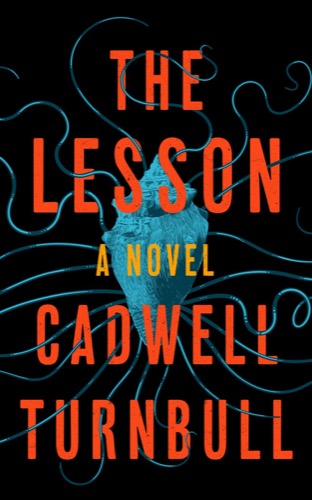
The Lesson by Cadwell Turnbull uses the alien invasion trope to examine a disturbingly human style of conquest: colonialism. In the Virgin Islands, humanity has negotiated an uneasy truce with the Ynaa – a group of aliens on a research mission they refuse to explain. While Ynaa maintain a peaceful facade with the locals, they are capable of disproportionate acts of violence when faced with human interference. After a young boy is found murdered by a Ynaa, the islanders’ fury reaches a boiling point. Unless these two species can come to terms with one another, they will be doomed to learn a lesson that history continues to teach.
Children of Time
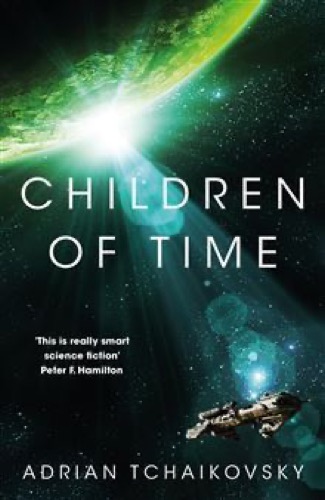
Children of Time by Adrian Tchaikovsky turns the alien invasion trope on its ear – by making us the bad guys. In the distant future, humanity has terraformed faraway planets to serve as our new home after Earth dies. When a group of colonists lands on one of these garden worlds, they’re shocked to find a different intelligent species has already set up shop. Due to a terraforming error, primates on this planet died out, and spiders became the dominate species. The planet may be ruled by an arachnid civilization, but the human colonists want to stamp them out like bugs. This novel is a tragic examination of what it means to be “human” – and what happens with a species of uplifted spiders is capable of showing more humanity than human beings themselves.
Lagoon
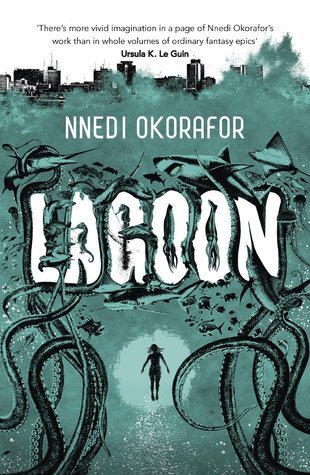
Lagoon by Nnedi Okorafor is an alien invasion story told through the lens of African folklore. This half fantasy, half sci-fi epic begins with a crash landing; an alien being has touched down off the coast of Lagos, and a soldier, a rapper, and a marine biologist are first humans around to make contact. While humanity’s relationship with the alien shapeshifters begins cordially, human/extraterrestrial relations break down when the newcomers begin to rapidly alter reality itself. One of the most significant changes? The barrier between the human and spirit world breaks down, and magical beings of African folklore begin seeping into mundane reality. While the tale carries the threat of annihilation, it’s ultimately one of integration – a picture of a world forever changed by new inhabitants.
A Door Into Ocean
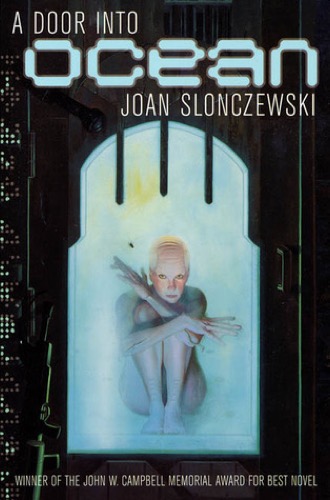
A Door Into Ocean by Joan Slonczewski chronicles a battle with alien invaders fought with the unlikeliest of tactics: non-violent resistance. On the water world of Shora, an all female group of beings called The Sharers live a peaceful existence in ecological harmony with their planet. When their planet is invaded by a warlike neighbor, they attempt to repel their aggressors without the use of lethal force – not because they lack the means to be violent, but the motive. The Sharers as a species have no concept of violence, and therefore refuse to adhere to the “rules” of warfare – to the bafflement of their militaristic invaders. A groundbreaking work of feminist sci-fi, A Door Into Ocean dreams of a world where conflict can be solved without violence, and an invading army can be defeated by taking the moral high ground. I mean, high seas.
Annihilation

Jeff VanderMeer’s Annihilation is the most subtly insidious tale of alien invasion on this list. In an undisclosed stretch of wilderness, Earth is slowly being consumed by an environmental anomaly dubbed Area X. Separated from the rest of the world by a shimmering border, only one thing is certain about the mysterious ecological phenomenon: those who enter it seldom come back. Despite the danger, the scientists at the Southern Reach facility have decided to deal with the problem by throwing waves of personnel at it, and an all female team of experts are the next to be sent through the shimmering boundary. Beyond the border, the physical word appears to slowly be breaking down – along with the sanity of anyone who stays too long. And worst of all? Area X is spreading more and more on the daily. This novel is a rare instance of environmental cosmic horror, similar to H.P. Lovecraft’s The Color Out of Space – but not written by a total bigot.
Have a tip we should know? [email protected]







